Comprehensive Report on Cash Management and Capital Budgeting
VerifiedAdded on 2020/04/21
|13
|3888
|249
Report
AI Summary
This report provides a comprehensive overview of cash management and capital budgeting. It begins by differentiating between profit and cash flow, explaining the importance of working capital, and illustrating how changes in working capital impact cash flow. The report then delves into strategies for improving cash flow, including forecasting, debt collection, and risk management. The second part of the report focuses on capital budgeting, outlining its purpose, process, and various investment appraisal methods like Payback Period, Net Present Value (NPV), and Internal Rate of Return (IRR). It discusses the advantages and disadvantages of each method and provides hypothetical illustrations to aid in decision-making. The report concludes with recommendations for optimizing cash management and capital budgeting practices within a business context, offering a detailed analysis of financial planning and investment strategies.
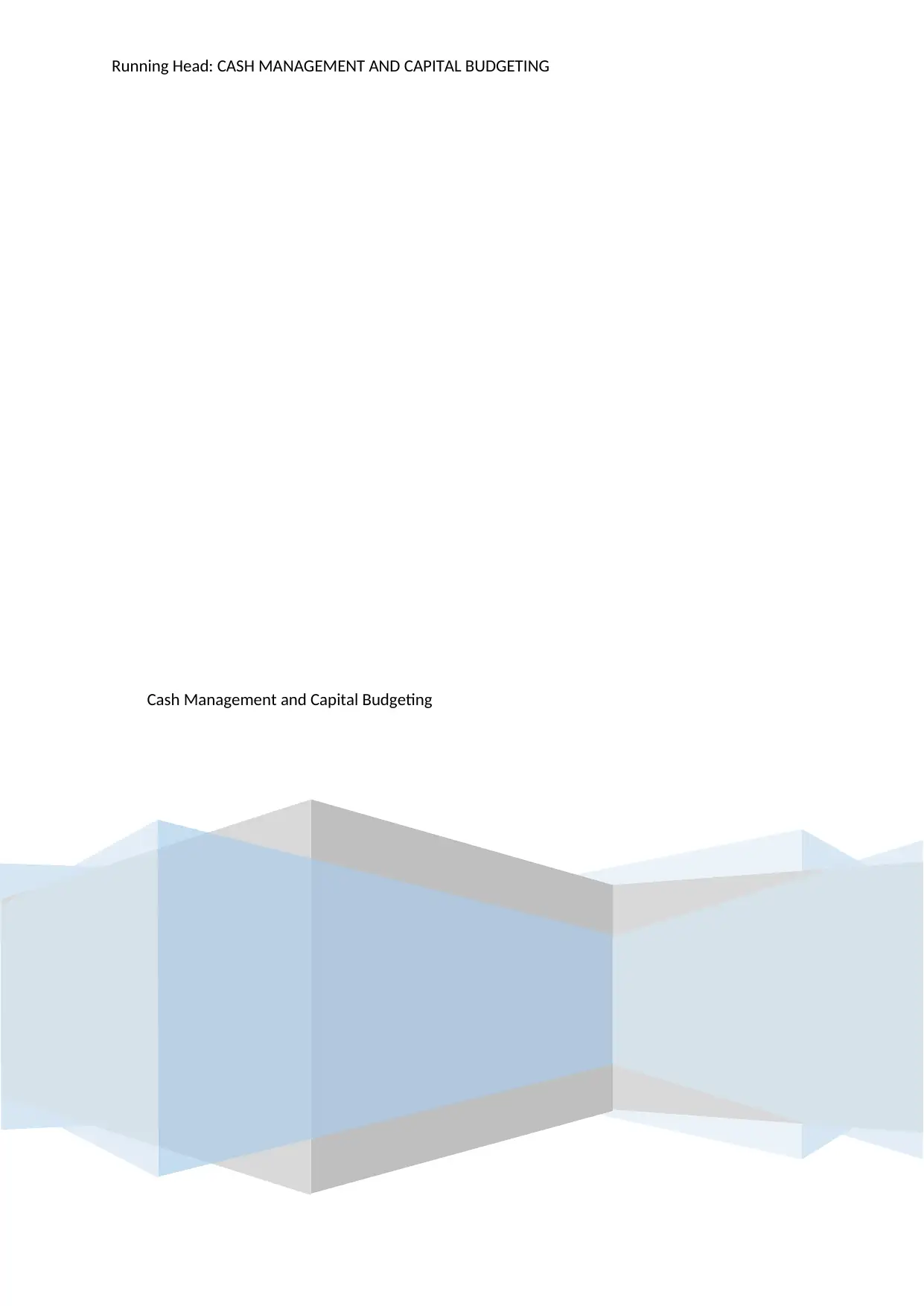
Running Head: CASH MANAGEMENT AND CAPITAL BUDGETING
Cash Management and Capital Budgeting
Cash Management and Capital Budgeting
Paraphrase This Document
Need a fresh take? Get an instant paraphrase of this document with our AI Paraphraser
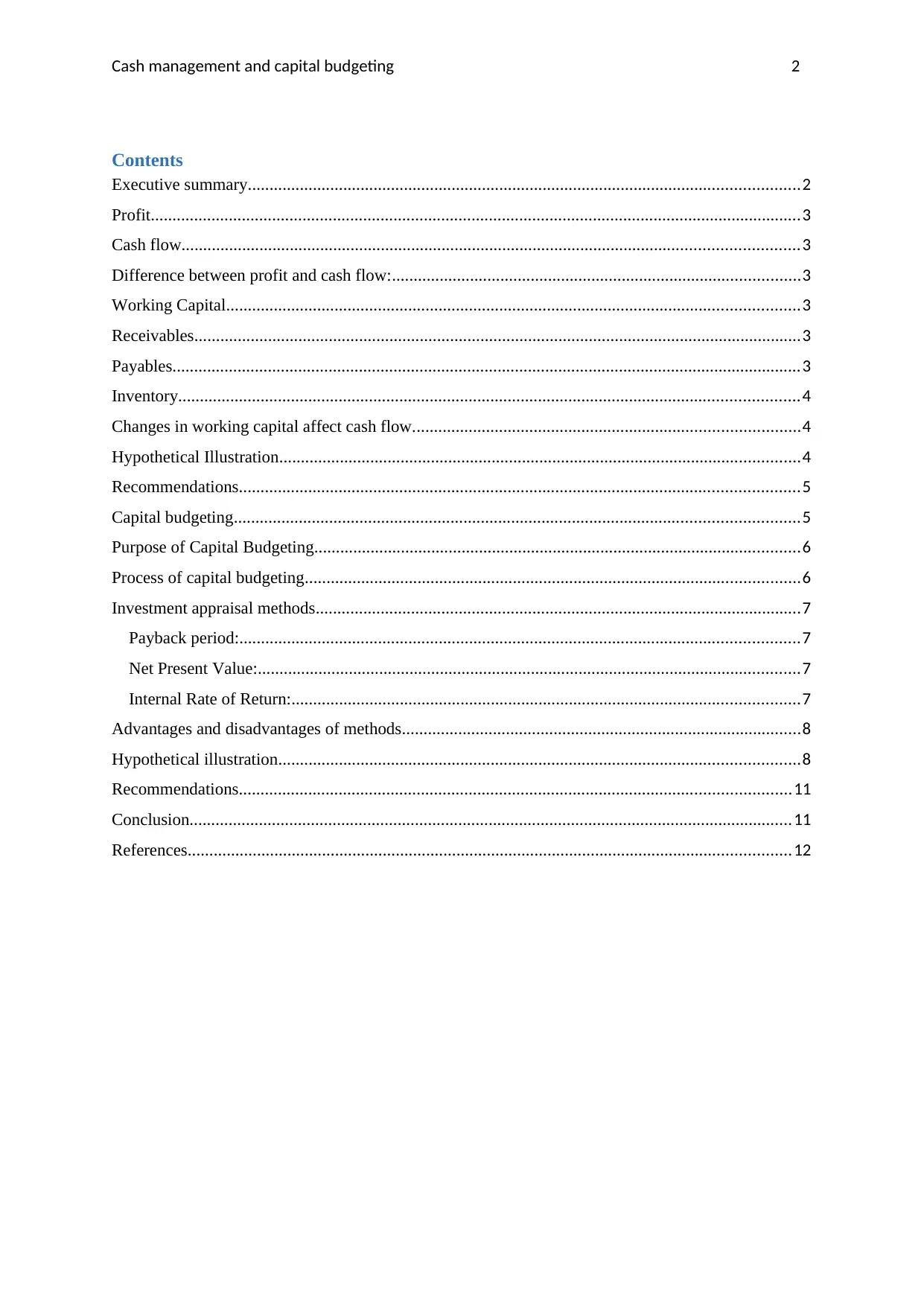
Cash management and capital budgeting 2
Contents
Executive summary...............................................................................................................................2
Profit......................................................................................................................................................3
Cash flow..............................................................................................................................................3
Difference between profit and cash flow:..............................................................................................3
Working Capital....................................................................................................................................3
Receivables............................................................................................................................................3
Payables.................................................................................................................................................3
Inventory...............................................................................................................................................4
Changes in working capital affect cash flow.........................................................................................4
Hypothetical Illustration........................................................................................................................4
Recommendations.................................................................................................................................5
Capital budgeting..................................................................................................................................5
Purpose of Capital Budgeting................................................................................................................6
Process of capital budgeting..................................................................................................................6
Investment appraisal methods................................................................................................................7
Payback period:.................................................................................................................................7
Net Present Value:.............................................................................................................................7
Internal Rate of Return:.....................................................................................................................7
Advantages and disadvantages of methods............................................................................................8
Hypothetical illustration........................................................................................................................8
Recommendations...............................................................................................................................11
Conclusion...........................................................................................................................................11
References...........................................................................................................................................12
Contents
Executive summary...............................................................................................................................2
Profit......................................................................................................................................................3
Cash flow..............................................................................................................................................3
Difference between profit and cash flow:..............................................................................................3
Working Capital....................................................................................................................................3
Receivables............................................................................................................................................3
Payables.................................................................................................................................................3
Inventory...............................................................................................................................................4
Changes in working capital affect cash flow.........................................................................................4
Hypothetical Illustration........................................................................................................................4
Recommendations.................................................................................................................................5
Capital budgeting..................................................................................................................................5
Purpose of Capital Budgeting................................................................................................................6
Process of capital budgeting..................................................................................................................6
Investment appraisal methods................................................................................................................7
Payback period:.................................................................................................................................7
Net Present Value:.............................................................................................................................7
Internal Rate of Return:.....................................................................................................................7
Advantages and disadvantages of methods............................................................................................8
Hypothetical illustration........................................................................................................................8
Recommendations...............................................................................................................................11
Conclusion...........................................................................................................................................11
References...........................................................................................................................................12
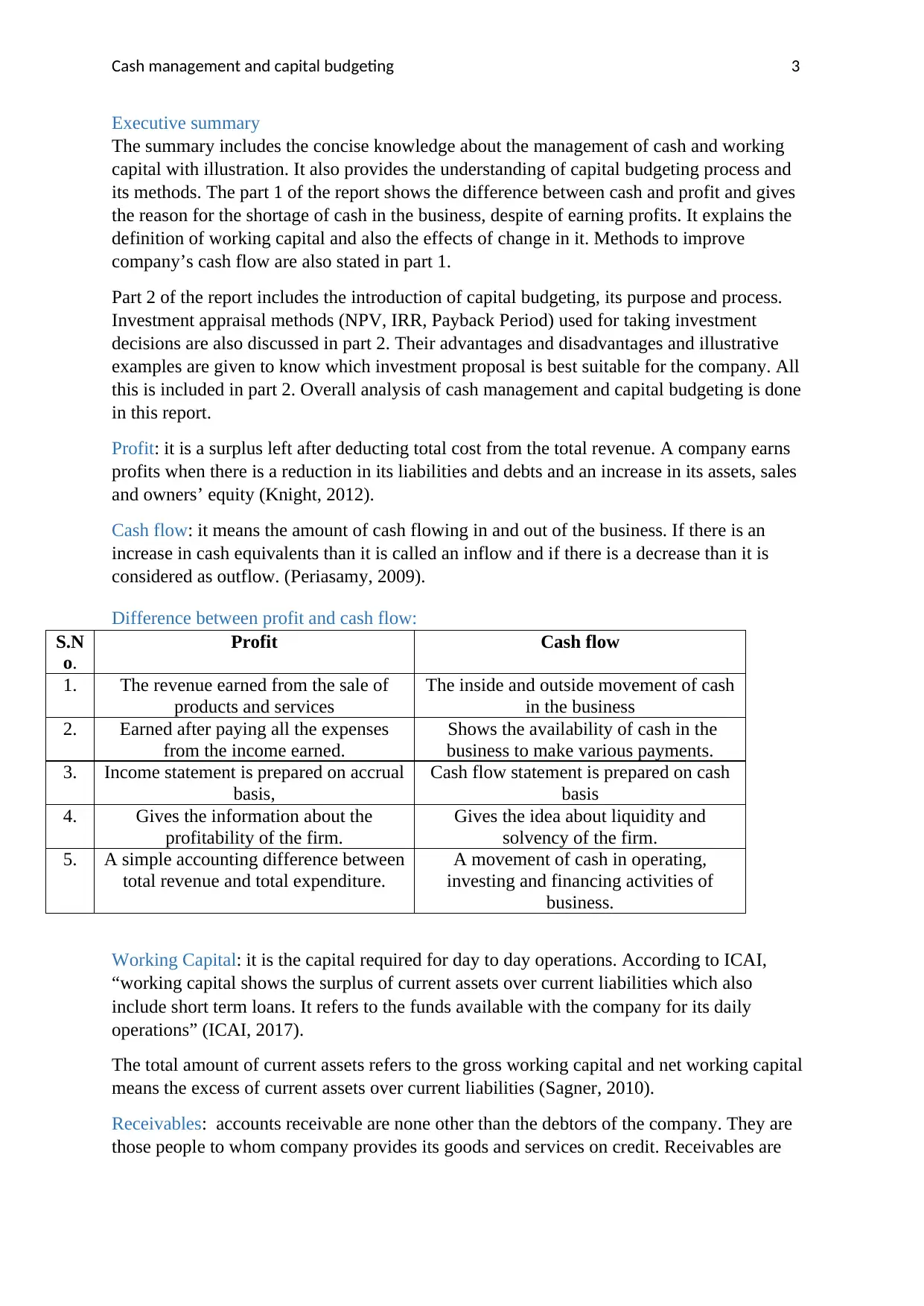
Cash management and capital budgeting 3
Executive summary
The summary includes the concise knowledge about the management of cash and working
capital with illustration. It also provides the understanding of capital budgeting process and
its methods. The part 1 of the report shows the difference between cash and profit and gives
the reason for the shortage of cash in the business, despite of earning profits. It explains the
definition of working capital and also the effects of change in it. Methods to improve
company’s cash flow are also stated in part 1.
Part 2 of the report includes the introduction of capital budgeting, its purpose and process.
Investment appraisal methods (NPV, IRR, Payback Period) used for taking investment
decisions are also discussed in part 2. Their advantages and disadvantages and illustrative
examples are given to know which investment proposal is best suitable for the company. All
this is included in part 2. Overall analysis of cash management and capital budgeting is done
in this report.
Profit: it is a surplus left after deducting total cost from the total revenue. A company earns
profits when there is a reduction in its liabilities and debts and an increase in its assets, sales
and owners’ equity (Knight, 2012).
Cash flow: it means the amount of cash flowing in and out of the business. If there is an
increase in cash equivalents than it is called an inflow and if there is a decrease than it is
considered as outflow. (Periasamy, 2009).
Difference between profit and cash flow:
S.N
o.
Profit Cash flow
1. The revenue earned from the sale of
products and services
The inside and outside movement of cash
in the business
2. Earned after paying all the expenses
from the income earned.
Shows the availability of cash in the
business to make various payments.
3. Income statement is prepared on accrual
basis,
Cash flow statement is prepared on cash
basis
4. Gives the information about the
profitability of the firm.
Gives the idea about liquidity and
solvency of the firm.
5. A simple accounting difference between
total revenue and total expenditure.
A movement of cash in operating,
investing and financing activities of
business.
Working Capital: it is the capital required for day to day operations. According to ICAI,
“working capital shows the surplus of current assets over current liabilities which also
include short term loans. It refers to the funds available with the company for its daily
operations” (ICAI, 2017).
The total amount of current assets refers to the gross working capital and net working capital
means the excess of current assets over current liabilities (Sagner, 2010).
Receivables: accounts receivable are none other than the debtors of the company. They are
those people to whom company provides its goods and services on credit. Receivables are
Executive summary
The summary includes the concise knowledge about the management of cash and working
capital with illustration. It also provides the understanding of capital budgeting process and
its methods. The part 1 of the report shows the difference between cash and profit and gives
the reason for the shortage of cash in the business, despite of earning profits. It explains the
definition of working capital and also the effects of change in it. Methods to improve
company’s cash flow are also stated in part 1.
Part 2 of the report includes the introduction of capital budgeting, its purpose and process.
Investment appraisal methods (NPV, IRR, Payback Period) used for taking investment
decisions are also discussed in part 2. Their advantages and disadvantages and illustrative
examples are given to know which investment proposal is best suitable for the company. All
this is included in part 2. Overall analysis of cash management and capital budgeting is done
in this report.
Profit: it is a surplus left after deducting total cost from the total revenue. A company earns
profits when there is a reduction in its liabilities and debts and an increase in its assets, sales
and owners’ equity (Knight, 2012).
Cash flow: it means the amount of cash flowing in and out of the business. If there is an
increase in cash equivalents than it is called an inflow and if there is a decrease than it is
considered as outflow. (Periasamy, 2009).
Difference between profit and cash flow:
S.N
o.
Profit Cash flow
1. The revenue earned from the sale of
products and services
The inside and outside movement of cash
in the business
2. Earned after paying all the expenses
from the income earned.
Shows the availability of cash in the
business to make various payments.
3. Income statement is prepared on accrual
basis,
Cash flow statement is prepared on cash
basis
4. Gives the information about the
profitability of the firm.
Gives the idea about liquidity and
solvency of the firm.
5. A simple accounting difference between
total revenue and total expenditure.
A movement of cash in operating,
investing and financing activities of
business.
Working Capital: it is the capital required for day to day operations. According to ICAI,
“working capital shows the surplus of current assets over current liabilities which also
include short term loans. It refers to the funds available with the company for its daily
operations” (ICAI, 2017).
The total amount of current assets refers to the gross working capital and net working capital
means the excess of current assets over current liabilities (Sagner, 2010).
Receivables: accounts receivable are none other than the debtors of the company. They are
those people to whom company provides its goods and services on credit. Receivables are
⊘ This is a preview!⊘
Do you want full access?
Subscribe today to unlock all pages.

Trusted by 1+ million students worldwide

Cash management and capital budgeting 4
part of the firm’s current assets. The customers who purchases on credit are required to pay
back the desired amount within the given time and date.
Payables: Account payables are the creditors of the company. They are those people from
whom, company purchase the material on credit. They are shown at the liability side of the
balance sheet. The creditors lend their goods and services to the company and get an
desirable amount in return.
Inventory: it is basically an asset of the firm. It means the stock of goods held with the
organisation for the purpose of sale. It includes the item purchased by the company for the
purpose of resale. There are three categories of it, which are:
Raw materials: these include those products which are required at the initial stage of
production.
Work-in-progress: unfinished items which are still in production process are known as
work-in-progress. These items are partially finished and are not ready for sale.
Finished goods: all the items or materials which have gone through the whole process
of production and are ready for sale to the customers in the market are known as
finished goods.
Inventory is termed as a current asset because it gets converted in cash within one year (Wild,
2017).
Changes in working capital affect cash flow.
The changes in the capital, directly affect the firm’s cash flow. An increase in it means the
current assets has raised through investing the resources which will reduce the flow of cash in
business (Icmai.in, 2017). On the other hand, decrease in capital means that firm’s current
liabilities has increased. Rise in current liabilities is considered as net cash inflow which
means, the company has more cash available with it to use for other projects. It is very
important to analyse the changes in working capital as they affect cash flow as well as the
overall performance of the business (Faulkender, et al., 2012).
Hypothetical Illustration
Cash Flow Statement Amount (£)
A Cash flow from Operating activities
Cash received from customers 70000
cash paid -50000
Increase/Decrease in Working Capital
Increase in Creditors 10000
Increase in Debtors -5000
Cash flow from Operating activities 25000
B Cash flow from Investing activities
receipts from sale of vehicle 10000
equipment purchase -15000
Cash used in investing activities -5000
C Cash flow from Financing activities
Payment of Loan -40000
part of the firm’s current assets. The customers who purchases on credit are required to pay
back the desired amount within the given time and date.
Payables: Account payables are the creditors of the company. They are those people from
whom, company purchase the material on credit. They are shown at the liability side of the
balance sheet. The creditors lend their goods and services to the company and get an
desirable amount in return.
Inventory: it is basically an asset of the firm. It means the stock of goods held with the
organisation for the purpose of sale. It includes the item purchased by the company for the
purpose of resale. There are three categories of it, which are:
Raw materials: these include those products which are required at the initial stage of
production.
Work-in-progress: unfinished items which are still in production process are known as
work-in-progress. These items are partially finished and are not ready for sale.
Finished goods: all the items or materials which have gone through the whole process
of production and are ready for sale to the customers in the market are known as
finished goods.
Inventory is termed as a current asset because it gets converted in cash within one year (Wild,
2017).
Changes in working capital affect cash flow.
The changes in the capital, directly affect the firm’s cash flow. An increase in it means the
current assets has raised through investing the resources which will reduce the flow of cash in
business (Icmai.in, 2017). On the other hand, decrease in capital means that firm’s current
liabilities has increased. Rise in current liabilities is considered as net cash inflow which
means, the company has more cash available with it to use for other projects. It is very
important to analyse the changes in working capital as they affect cash flow as well as the
overall performance of the business (Faulkender, et al., 2012).
Hypothetical Illustration
Cash Flow Statement Amount (£)
A Cash flow from Operating activities
Cash received from customers 70000
cash paid -50000
Increase/Decrease in Working Capital
Increase in Creditors 10000
Increase in Debtors -5000
Cash flow from Operating activities 25000
B Cash flow from Investing activities
receipts from sale of vehicle 10000
equipment purchase -15000
Cash used in investing activities -5000
C Cash flow from Financing activities
Payment of Loan -40000
Paraphrase This Document
Need a fresh take? Get an instant paraphrase of this document with our AI Paraphraser
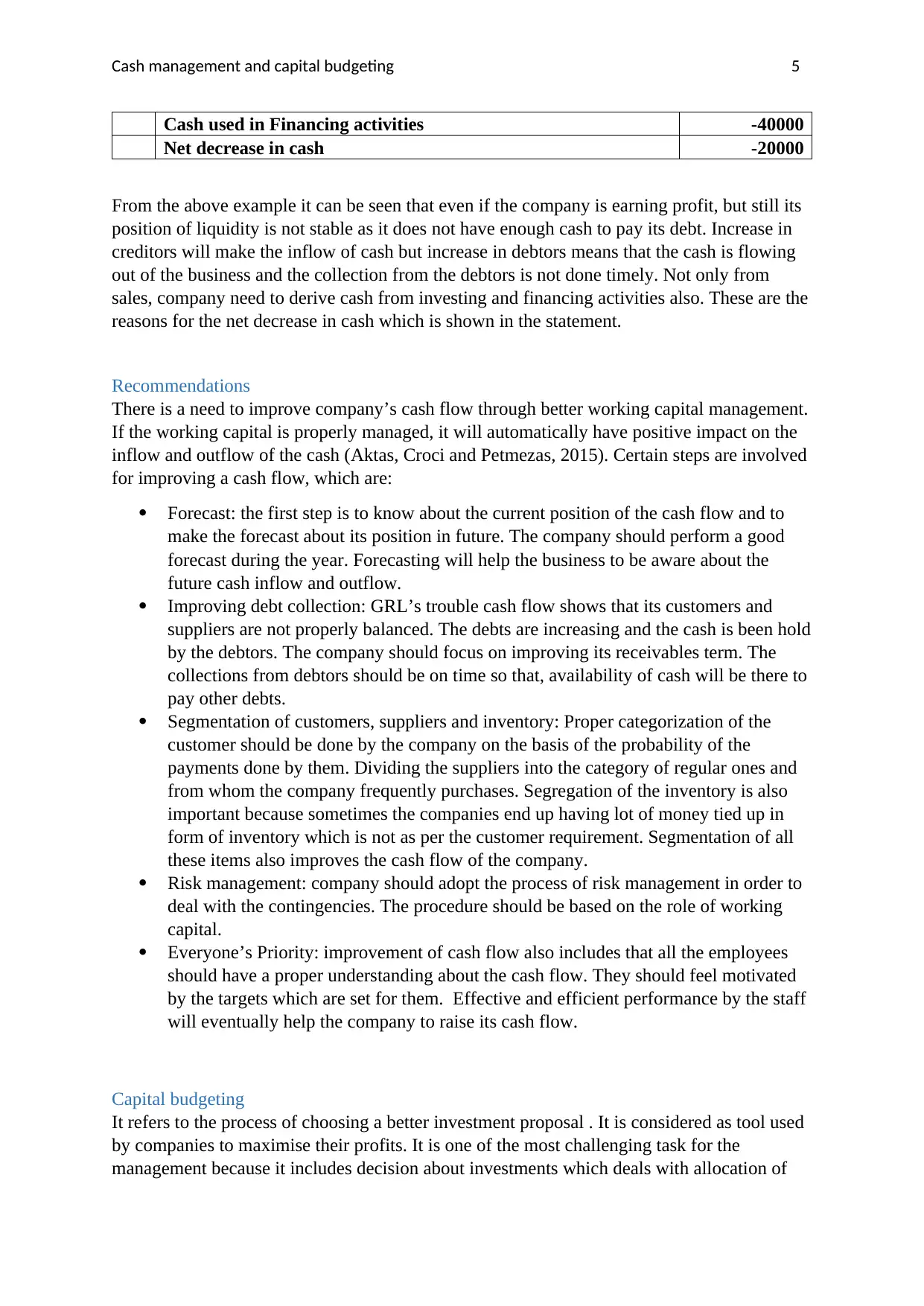
Cash management and capital budgeting 5
Cash used in Financing activities -40000
Net decrease in cash -20000
From the above example it can be seen that even if the company is earning profit, but still its
position of liquidity is not stable as it does not have enough cash to pay its debt. Increase in
creditors will make the inflow of cash but increase in debtors means that the cash is flowing
out of the business and the collection from the debtors is not done timely. Not only from
sales, company need to derive cash from investing and financing activities also. These are the
reasons for the net decrease in cash which is shown in the statement.
Recommendations
There is a need to improve company’s cash flow through better working capital management.
If the working capital is properly managed, it will automatically have positive impact on the
inflow and outflow of the cash (Aktas, Croci and Petmezas, 2015). Certain steps are involved
for improving a cash flow, which are:
Forecast: the first step is to know about the current position of the cash flow and to
make the forecast about its position in future. The company should perform a good
forecast during the year. Forecasting will help the business to be aware about the
future cash inflow and outflow.
Improving debt collection: GRL’s trouble cash flow shows that its customers and
suppliers are not properly balanced. The debts are increasing and the cash is been hold
by the debtors. The company should focus on improving its receivables term. The
collections from debtors should be on time so that, availability of cash will be there to
pay other debts.
Segmentation of customers, suppliers and inventory: Proper categorization of the
customer should be done by the company on the basis of the probability of the
payments done by them. Dividing the suppliers into the category of regular ones and
from whom the company frequently purchases. Segregation of the inventory is also
important because sometimes the companies end up having lot of money tied up in
form of inventory which is not as per the customer requirement. Segmentation of all
these items also improves the cash flow of the company.
Risk management: company should adopt the process of risk management in order to
deal with the contingencies. The procedure should be based on the role of working
capital.
Everyone’s Priority: improvement of cash flow also includes that all the employees
should have a proper understanding about the cash flow. They should feel motivated
by the targets which are set for them. Effective and efficient performance by the staff
will eventually help the company to raise its cash flow.
Capital budgeting
It refers to the process of choosing a better investment proposal . It is considered as tool used
by companies to maximise their profits. It is one of the most challenging task for the
management because it includes decision about investments which deals with allocation of
Cash used in Financing activities -40000
Net decrease in cash -20000
From the above example it can be seen that even if the company is earning profit, but still its
position of liquidity is not stable as it does not have enough cash to pay its debt. Increase in
creditors will make the inflow of cash but increase in debtors means that the cash is flowing
out of the business and the collection from the debtors is not done timely. Not only from
sales, company need to derive cash from investing and financing activities also. These are the
reasons for the net decrease in cash which is shown in the statement.
Recommendations
There is a need to improve company’s cash flow through better working capital management.
If the working capital is properly managed, it will automatically have positive impact on the
inflow and outflow of the cash (Aktas, Croci and Petmezas, 2015). Certain steps are involved
for improving a cash flow, which are:
Forecast: the first step is to know about the current position of the cash flow and to
make the forecast about its position in future. The company should perform a good
forecast during the year. Forecasting will help the business to be aware about the
future cash inflow and outflow.
Improving debt collection: GRL’s trouble cash flow shows that its customers and
suppliers are not properly balanced. The debts are increasing and the cash is been hold
by the debtors. The company should focus on improving its receivables term. The
collections from debtors should be on time so that, availability of cash will be there to
pay other debts.
Segmentation of customers, suppliers and inventory: Proper categorization of the
customer should be done by the company on the basis of the probability of the
payments done by them. Dividing the suppliers into the category of regular ones and
from whom the company frequently purchases. Segregation of the inventory is also
important because sometimes the companies end up having lot of money tied up in
form of inventory which is not as per the customer requirement. Segmentation of all
these items also improves the cash flow of the company.
Risk management: company should adopt the process of risk management in order to
deal with the contingencies. The procedure should be based on the role of working
capital.
Everyone’s Priority: improvement of cash flow also includes that all the employees
should have a proper understanding about the cash flow. They should feel motivated
by the targets which are set for them. Effective and efficient performance by the staff
will eventually help the company to raise its cash flow.
Capital budgeting
It refers to the process of choosing a better investment proposal . It is considered as tool used
by companies to maximise their profits. It is one of the most challenging task for the
management because it includes decision about investments which deals with allocation of
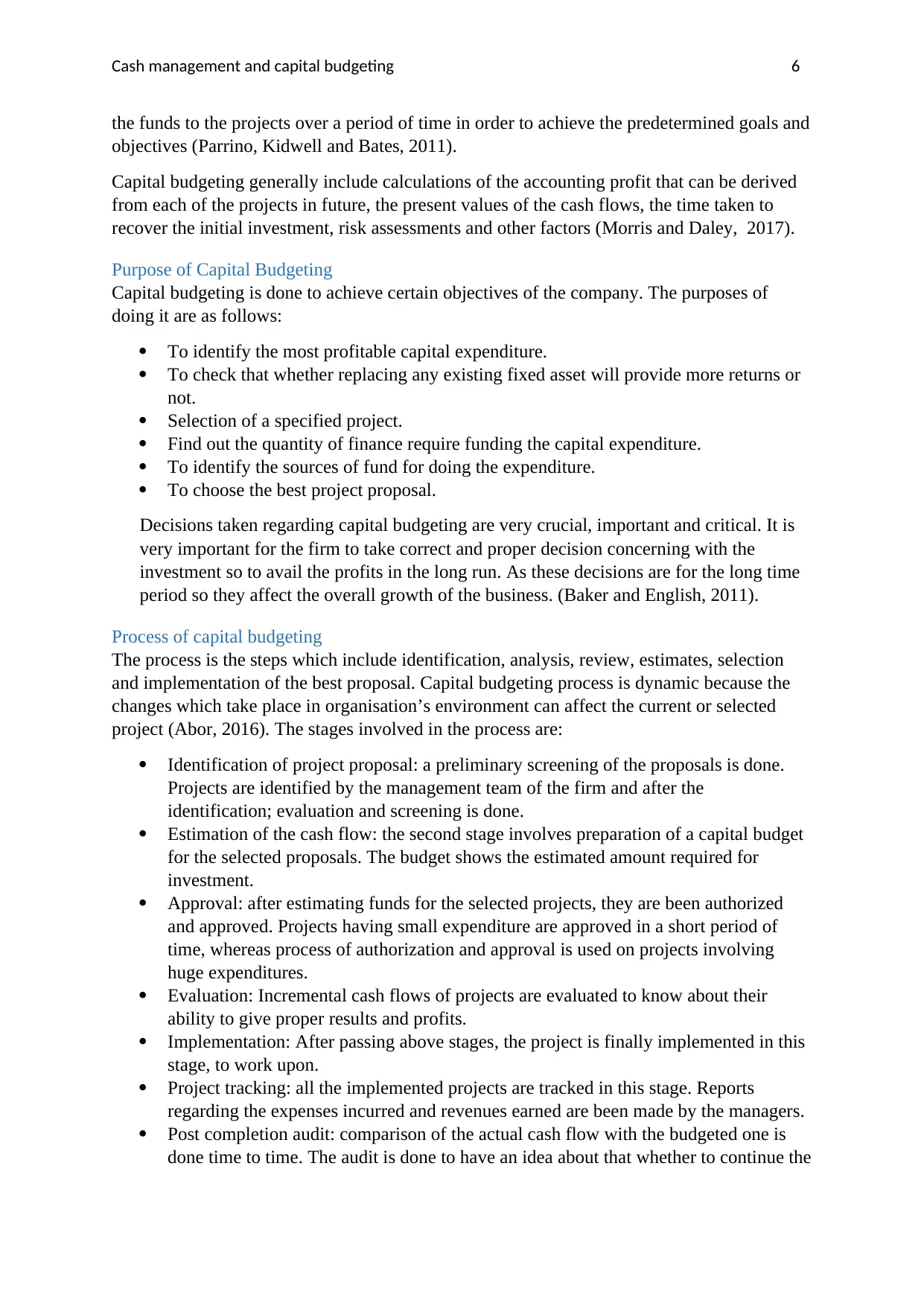
Cash management and capital budgeting 6
the funds to the projects over a period of time in order to achieve the predetermined goals and
objectives (Parrino, Kidwell and Bates, 2011).
Capital budgeting generally include calculations of the accounting profit that can be derived
from each of the projects in future, the present values of the cash flows, the time taken to
recover the initial investment, risk assessments and other factors (Morris and Daley, 2017).
Purpose of Capital Budgeting
Capital budgeting is done to achieve certain objectives of the company. The purposes of
doing it are as follows:
To identify the most profitable capital expenditure.
To check that whether replacing any existing fixed asset will provide more returns or
not.
Selection of a specified project.
Find out the quantity of finance require funding the capital expenditure.
To identify the sources of fund for doing the expenditure.
To choose the best project proposal.
Decisions taken regarding capital budgeting are very crucial, important and critical. It is
very important for the firm to take correct and proper decision concerning with the
investment so to avail the profits in the long run. As these decisions are for the long time
period so they affect the overall growth of the business. (Baker and English, 2011).
Process of capital budgeting
The process is the steps which include identification, analysis, review, estimates, selection
and implementation of the best proposal. Capital budgeting process is dynamic because the
changes which take place in organisation’s environment can affect the current or selected
project (Abor, 2016). The stages involved in the process are:
Identification of project proposal: a preliminary screening of the proposals is done.
Projects are identified by the management team of the firm and after the
identification; evaluation and screening is done.
Estimation of the cash flow: the second stage involves preparation of a capital budget
for the selected proposals. The budget shows the estimated amount required for
investment.
Approval: after estimating funds for the selected projects, they are been authorized
and approved. Projects having small expenditure are approved in a short period of
time, whereas process of authorization and approval is used on projects involving
huge expenditures.
Evaluation: Incremental cash flows of projects are evaluated to know about their
ability to give proper results and profits.
Implementation: After passing above stages, the project is finally implemented in this
stage, to work upon.
Project tracking: all the implemented projects are tracked in this stage. Reports
regarding the expenses incurred and revenues earned are been made by the managers.
Post completion audit: comparison of the actual cash flow with the budgeted one is
done time to time. The audit is done to have an idea about that whether to continue the
the funds to the projects over a period of time in order to achieve the predetermined goals and
objectives (Parrino, Kidwell and Bates, 2011).
Capital budgeting generally include calculations of the accounting profit that can be derived
from each of the projects in future, the present values of the cash flows, the time taken to
recover the initial investment, risk assessments and other factors (Morris and Daley, 2017).
Purpose of Capital Budgeting
Capital budgeting is done to achieve certain objectives of the company. The purposes of
doing it are as follows:
To identify the most profitable capital expenditure.
To check that whether replacing any existing fixed asset will provide more returns or
not.
Selection of a specified project.
Find out the quantity of finance require funding the capital expenditure.
To identify the sources of fund for doing the expenditure.
To choose the best project proposal.
Decisions taken regarding capital budgeting are very crucial, important and critical. It is
very important for the firm to take correct and proper decision concerning with the
investment so to avail the profits in the long run. As these decisions are for the long time
period so they affect the overall growth of the business. (Baker and English, 2011).
Process of capital budgeting
The process is the steps which include identification, analysis, review, estimates, selection
and implementation of the best proposal. Capital budgeting process is dynamic because the
changes which take place in organisation’s environment can affect the current or selected
project (Abor, 2016). The stages involved in the process are:
Identification of project proposal: a preliminary screening of the proposals is done.
Projects are identified by the management team of the firm and after the
identification; evaluation and screening is done.
Estimation of the cash flow: the second stage involves preparation of a capital budget
for the selected proposals. The budget shows the estimated amount required for
investment.
Approval: after estimating funds for the selected projects, they are been authorized
and approved. Projects having small expenditure are approved in a short period of
time, whereas process of authorization and approval is used on projects involving
huge expenditures.
Evaluation: Incremental cash flows of projects are evaluated to know about their
ability to give proper results and profits.
Implementation: After passing above stages, the project is finally implemented in this
stage, to work upon.
Project tracking: all the implemented projects are tracked in this stage. Reports
regarding the expenses incurred and revenues earned are been made by the managers.
Post completion audit: comparison of the actual cash flow with the budgeted one is
done time to time. The audit is done to have an idea about that whether to continue the
⊘ This is a preview!⊘
Do you want full access?
Subscribe today to unlock all pages.

Trusted by 1+ million students worldwide
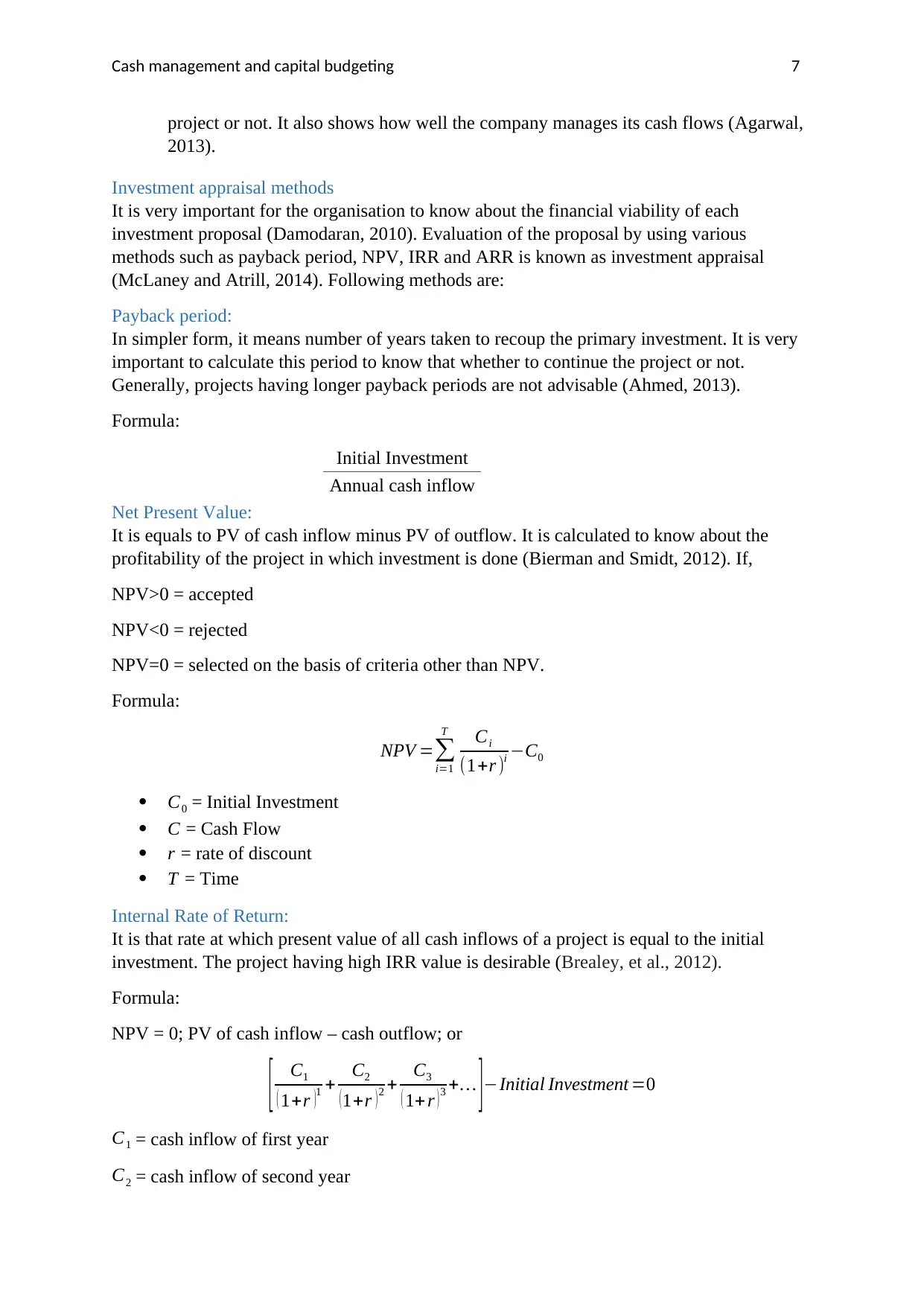
Cash management and capital budgeting 7
project or not. It also shows how well the company manages its cash flows (Agarwal,
2013).
Investment appraisal methods
It is very important for the organisation to know about the financial viability of each
investment proposal (Damodaran, 2010). Evaluation of the proposal by using various
methods such as payback period, NPV, IRR and ARR is known as investment appraisal
(McLaney and Atrill, 2014). Following methods are:
Payback period:
In simpler form, it means number of years taken to recoup the primary investment. It is very
important to calculate this period to know that whether to continue the project or not.
Generally, projects having longer payback periods are not advisable (Ahmed, 2013).
Formula:
Initial Investment
Annual cash inflow
Net Present Value:
It is equals to PV of cash inflow minus PV of outflow. It is calculated to know about the
profitability of the project in which investment is done (Bierman and Smidt, 2012). If,
NPV>0 = accepted
NPV<0 = rejected
NPV=0 = selected on the basis of criteria other than NPV.
Formula:
NPV =∑
i=1
T Ci
(1+r )i −C0
C0 = Initial Investment
C = Cash Flow
r = rate of discount
T = Time
Internal Rate of Return:
It is that rate at which present value of all cash inflows of a project is equal to the initial
investment. The project having high IRR value is desirable (Brealey, et al., 2012).
Formula:
NPV = 0; PV of cash inflow – cash outflow; or
[ C1
( 1+r )1 + C2
(1+r )2 + C3
( 1+ r )3 +… ]−Initial Investment =0
C1 = cash inflow of first year
C2 = cash inflow of second year
project or not. It also shows how well the company manages its cash flows (Agarwal,
2013).
Investment appraisal methods
It is very important for the organisation to know about the financial viability of each
investment proposal (Damodaran, 2010). Evaluation of the proposal by using various
methods such as payback period, NPV, IRR and ARR is known as investment appraisal
(McLaney and Atrill, 2014). Following methods are:
Payback period:
In simpler form, it means number of years taken to recoup the primary investment. It is very
important to calculate this period to know that whether to continue the project or not.
Generally, projects having longer payback periods are not advisable (Ahmed, 2013).
Formula:
Initial Investment
Annual cash inflow
Net Present Value:
It is equals to PV of cash inflow minus PV of outflow. It is calculated to know about the
profitability of the project in which investment is done (Bierman and Smidt, 2012). If,
NPV>0 = accepted
NPV<0 = rejected
NPV=0 = selected on the basis of criteria other than NPV.
Formula:
NPV =∑
i=1
T Ci
(1+r )i −C0
C0 = Initial Investment
C = Cash Flow
r = rate of discount
T = Time
Internal Rate of Return:
It is that rate at which present value of all cash inflows of a project is equal to the initial
investment. The project having high IRR value is desirable (Brealey, et al., 2012).
Formula:
NPV = 0; PV of cash inflow – cash outflow; or
[ C1
( 1+r )1 + C2
(1+r )2 + C3
( 1+ r )3 +… ]−Initial Investment =0
C1 = cash inflow of first year
C2 = cash inflow of second year
Paraphrase This Document
Need a fresh take? Get an instant paraphrase of this document with our AI Paraphraser
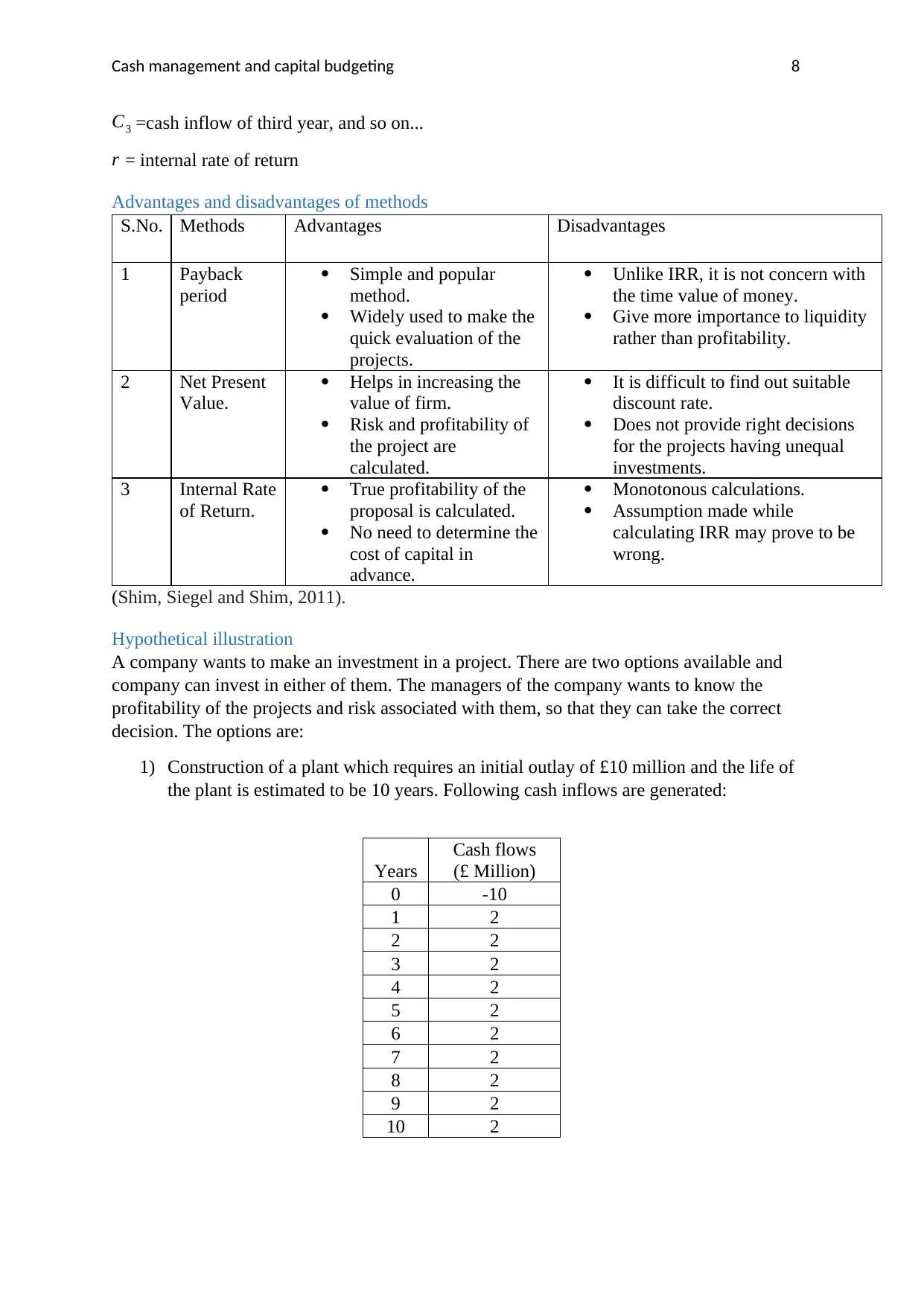
Cash management and capital budgeting 8
C3 =cash inflow of third year, and so on...
r = internal rate of return
Advantages and disadvantages of methods
S.No. Methods Advantages Disadvantages
1 Payback
period
Simple and popular
method.
Widely used to make the
quick evaluation of the
projects.
Unlike IRR, it is not concern with
the time value of money.
Give more importance to liquidity
rather than profitability.
2 Net Present
Value.
Helps in increasing the
value of firm.
Risk and profitability of
the project are
calculated.
It is difficult to find out suitable
discount rate.
Does not provide right decisions
for the projects having unequal
investments.
3 Internal Rate
of Return.
True profitability of the
proposal is calculated.
No need to determine the
cost of capital in
advance.
Monotonous calculations.
Assumption made while
calculating IRR may prove to be
wrong.
(Shim, Siegel and Shim, 2011).
Hypothetical illustration
A company wants to make an investment in a project. There are two options available and
company can invest in either of them. The managers of the company wants to know the
profitability of the projects and risk associated with them, so that they can take the correct
decision. The options are:
1) Construction of a plant which requires an initial outlay of £10 million and the life of
the plant is estimated to be 10 years. Following cash inflows are generated:
Years
Cash flows
(£ Million)
0 -10
1 2
2 2
3 2
4 2
5 2
6 2
7 2
8 2
9 2
10 2
C3 =cash inflow of third year, and so on...
r = internal rate of return
Advantages and disadvantages of methods
S.No. Methods Advantages Disadvantages
1 Payback
period
Simple and popular
method.
Widely used to make the
quick evaluation of the
projects.
Unlike IRR, it is not concern with
the time value of money.
Give more importance to liquidity
rather than profitability.
2 Net Present
Value.
Helps in increasing the
value of firm.
Risk and profitability of
the project are
calculated.
It is difficult to find out suitable
discount rate.
Does not provide right decisions
for the projects having unequal
investments.
3 Internal Rate
of Return.
True profitability of the
proposal is calculated.
No need to determine the
cost of capital in
advance.
Monotonous calculations.
Assumption made while
calculating IRR may prove to be
wrong.
(Shim, Siegel and Shim, 2011).
Hypothetical illustration
A company wants to make an investment in a project. There are two options available and
company can invest in either of them. The managers of the company wants to know the
profitability of the projects and risk associated with them, so that they can take the correct
decision. The options are:
1) Construction of a plant which requires an initial outlay of £10 million and the life of
the plant is estimated to be 10 years. Following cash inflows are generated:
Years
Cash flows
(£ Million)
0 -10
1 2
2 2
3 2
4 2
5 2
6 2
7 2
8 2
9 2
10 2
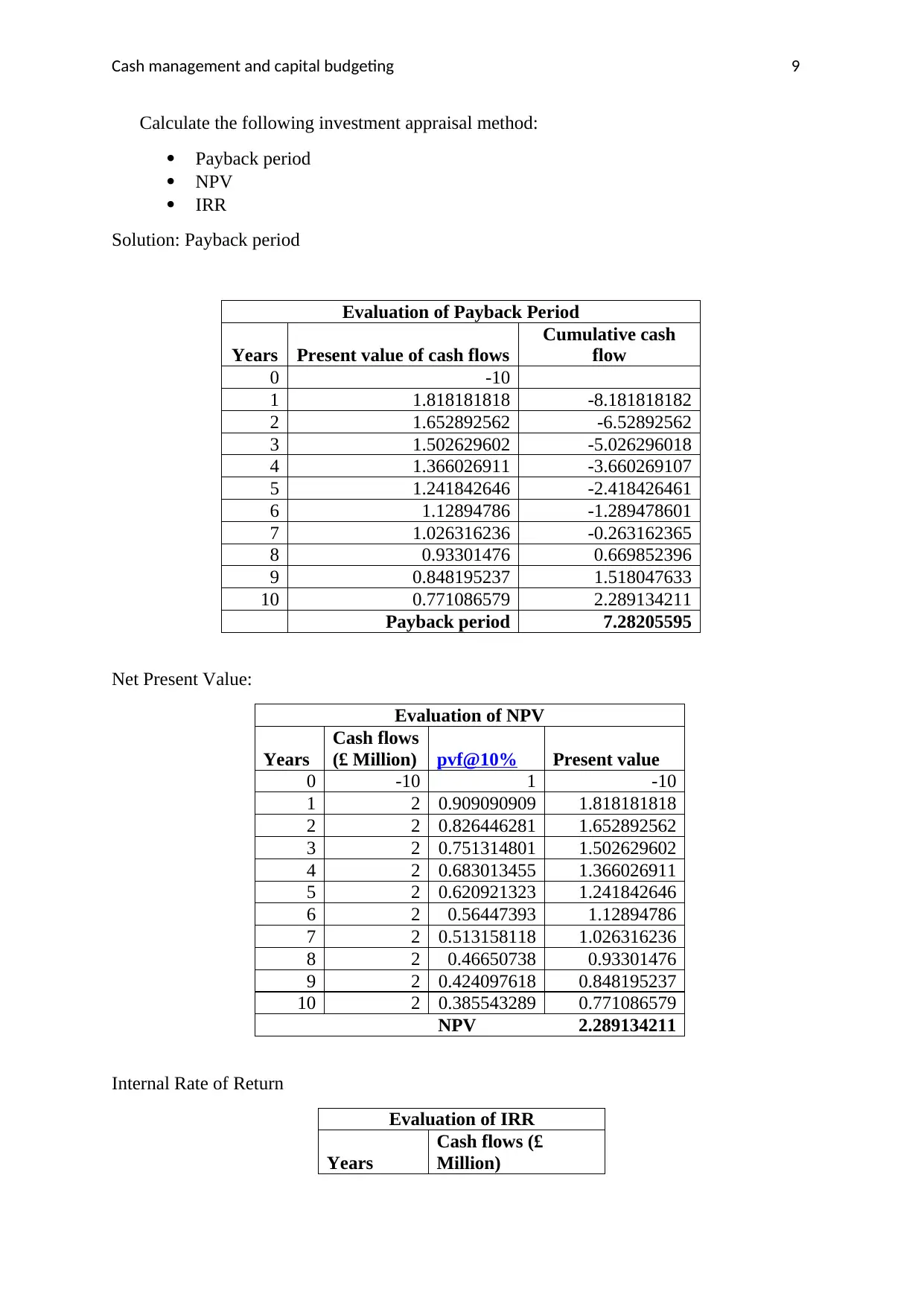
Cash management and capital budgeting 9
Calculate the following investment appraisal method:
Payback period
NPV
IRR
Solution: Payback period
Evaluation of Payback Period
Years Present value of cash flows
Cumulative cash
flow
0 -10
1 1.818181818 -8.181818182
2 1.652892562 -6.52892562
3 1.502629602 -5.026296018
4 1.366026911 -3.660269107
5 1.241842646 -2.418426461
6 1.12894786 -1.289478601
7 1.026316236 -0.263162365
8 0.93301476 0.669852396
9 0.848195237 1.518047633
10 0.771086579 2.289134211
Payback period 7.28205595
Net Present Value:
Evaluation of NPV
Years
Cash flows
(£ Million) pvf@10% Present value
0 -10 1 -10
1 2 0.909090909 1.818181818
2 2 0.826446281 1.652892562
3 2 0.751314801 1.502629602
4 2 0.683013455 1.366026911
5 2 0.620921323 1.241842646
6 2 0.56447393 1.12894786
7 2 0.513158118 1.026316236
8 2 0.46650738 0.93301476
9 2 0.424097618 0.848195237
10 2 0.385543289 0.771086579
NPV 2.289134211
Internal Rate of Return
Evaluation of IRR
Years
Cash flows (£
Million)
Calculate the following investment appraisal method:
Payback period
NPV
IRR
Solution: Payback period
Evaluation of Payback Period
Years Present value of cash flows
Cumulative cash
flow
0 -10
1 1.818181818 -8.181818182
2 1.652892562 -6.52892562
3 1.502629602 -5.026296018
4 1.366026911 -3.660269107
5 1.241842646 -2.418426461
6 1.12894786 -1.289478601
7 1.026316236 -0.263162365
8 0.93301476 0.669852396
9 0.848195237 1.518047633
10 0.771086579 2.289134211
Payback period 7.28205595
Net Present Value:
Evaluation of NPV
Years
Cash flows
(£ Million) pvf@10% Present value
0 -10 1 -10
1 2 0.909090909 1.818181818
2 2 0.826446281 1.652892562
3 2 0.751314801 1.502629602
4 2 0.683013455 1.366026911
5 2 0.620921323 1.241842646
6 2 0.56447393 1.12894786
7 2 0.513158118 1.026316236
8 2 0.46650738 0.93301476
9 2 0.424097618 0.848195237
10 2 0.385543289 0.771086579
NPV 2.289134211
Internal Rate of Return
Evaluation of IRR
Years
Cash flows (£
Million)
⊘ This is a preview!⊘
Do you want full access?
Subscribe today to unlock all pages.

Trusted by 1+ million students worldwide

Cash management and capital budgeting 10
0 -10
1 2
2 2
3 2
4 2
5 2
6 2
7 2
8 2
9 2
10 2
IRR 15%
2) Purchase of an existing outdated plant which will cost £6 million and have a life span
of 6 years. Following are the cash flows generated:
Years
Cash flows
(£million)
0 -6
1 2.1
2 2.1
3 2.1
4 2.1
5 2.1
6 2.1
Solution: calculation of the investment appraisal methods
Payback period
Evaluation of Payback Period
Year
s
Present value of cash
flows Cumulative cash flow
0 -6
1 1.909090909 -4.090909091
2 1.73553719 -2.355371901
3 1.577761082 -0.777610819
4 1.434328256 0.656717437
5 1.303934778 1.960652216
6 1.185395253 3.146047469
Payback period3.542142857
Net Present Value
Evaluation of NPV
Year
s
Cash flows (£
Million) pvf@10% Present value
0 -10
1 2
2 2
3 2
4 2
5 2
6 2
7 2
8 2
9 2
10 2
IRR 15%
2) Purchase of an existing outdated plant which will cost £6 million and have a life span
of 6 years. Following are the cash flows generated:
Years
Cash flows
(£million)
0 -6
1 2.1
2 2.1
3 2.1
4 2.1
5 2.1
6 2.1
Solution: calculation of the investment appraisal methods
Payback period
Evaluation of Payback Period
Year
s
Present value of cash
flows Cumulative cash flow
0 -6
1 1.909090909 -4.090909091
2 1.73553719 -2.355371901
3 1.577761082 -0.777610819
4 1.434328256 0.656717437
5 1.303934778 1.960652216
6 1.185395253 3.146047469
Payback period3.542142857
Net Present Value
Evaluation of NPV
Year
s
Cash flows (£
Million) pvf@10% Present value
Paraphrase This Document
Need a fresh take? Get an instant paraphrase of this document with our AI Paraphraser

Cash management and capital budgeting 11
0 -6 1 -6
1 2.1 0.909090909 1.909090909
2 2.1 0.826446281 1.73553719
3 2.1 0.751314801 1.577761082
4 2.1 0.683013455 1.434328256
5 2.1 0.620921323 1.303934778
6 2.1 0.56447393 1.185395253
NPV 3.146047469
Internal Rate of Return
Evaluation of IRR
Years Cash flows (£ Million)
0 -6
1 2.1
2 2.1
3 2.1
4 2.1
5 2.1
6 2.1
IRR 26%
Recommendations
Projects having short payback period, high NPV and higher IRR are considered to be the
most profitable, acceptable and desirable projects to invest in. As far as, GRL is concerned, it
has two investment options, one is regarding the construction on a site which requires an
initial investment of £10 million and will get completed in 9 to 10 years. Whereas the other
option is to take over the existing outdated plant for £6 million which has a useful life of 5-6
years. Above calculation with an example is done to know which the most profitable
investment option is.
It can be seen that the proposal, whose cash outflow is £10 million have a payback
period of 7.28 years whereas the payback period of other option is only 3.54 years.
The net present value of first option is 2.28 and of the other, it is 3.14.
Internal Rate of Return for the proposal first is 15% and for the other one it is 26%.
So it is clear that the option of taking over the existing outdated plant is much better than
investing in the construction project because it has a shorter payback period as compare to
other and have a higher net present value and internal rate of return. By investing in proposal
second, GRL will be able to recover the initial investment soon as it has short payback period
and the project will be more profitable in future because of its higher NPV and IRR as
compare to the first proposal. Company should go for the second option as it is more suitable
and acceptable (Atrill and McLaney, 2009).
Conclusion
This report concludes that it is very necessary for the company to properly manage its cash
and working capital in order to have an efficient and effective growth. It is also important to
0 -6 1 -6
1 2.1 0.909090909 1.909090909
2 2.1 0.826446281 1.73553719
3 2.1 0.751314801 1.577761082
4 2.1 0.683013455 1.434328256
5 2.1 0.620921323 1.303934778
6 2.1 0.56447393 1.185395253
NPV 3.146047469
Internal Rate of Return
Evaluation of IRR
Years Cash flows (£ Million)
0 -6
1 2.1
2 2.1
3 2.1
4 2.1
5 2.1
6 2.1
IRR 26%
Recommendations
Projects having short payback period, high NPV and higher IRR are considered to be the
most profitable, acceptable and desirable projects to invest in. As far as, GRL is concerned, it
has two investment options, one is regarding the construction on a site which requires an
initial investment of £10 million and will get completed in 9 to 10 years. Whereas the other
option is to take over the existing outdated plant for £6 million which has a useful life of 5-6
years. Above calculation with an example is done to know which the most profitable
investment option is.
It can be seen that the proposal, whose cash outflow is £10 million have a payback
period of 7.28 years whereas the payback period of other option is only 3.54 years.
The net present value of first option is 2.28 and of the other, it is 3.14.
Internal Rate of Return for the proposal first is 15% and for the other one it is 26%.
So it is clear that the option of taking over the existing outdated plant is much better than
investing in the construction project because it has a shorter payback period as compare to
other and have a higher net present value and internal rate of return. By investing in proposal
second, GRL will be able to recover the initial investment soon as it has short payback period
and the project will be more profitable in future because of its higher NPV and IRR as
compare to the first proposal. Company should go for the second option as it is more suitable
and acceptable (Atrill and McLaney, 2009).
Conclusion
This report concludes that it is very necessary for the company to properly manage its cash
and working capital in order to have an efficient and effective growth. It is also important to
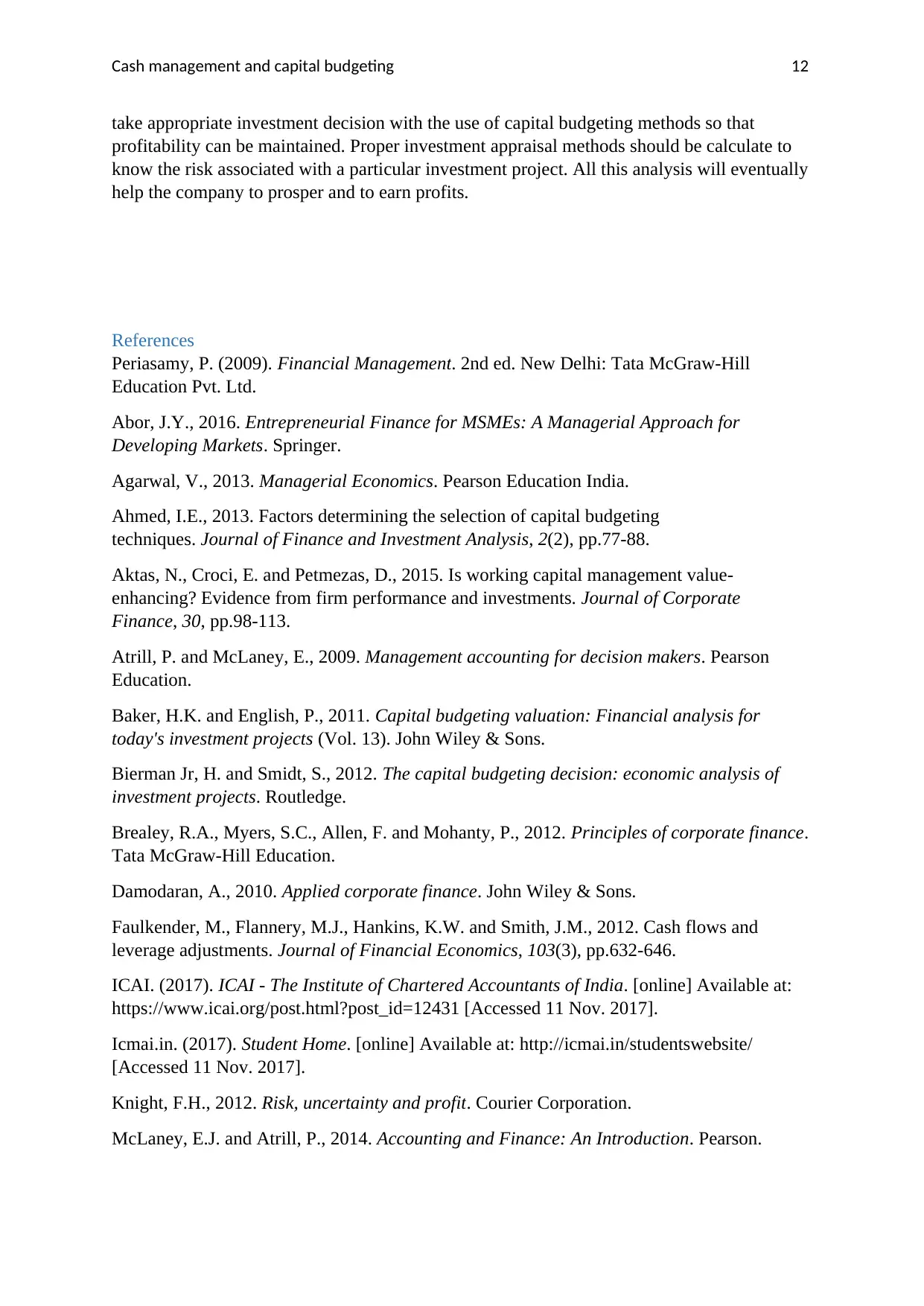
Cash management and capital budgeting 12
take appropriate investment decision with the use of capital budgeting methods so that
profitability can be maintained. Proper investment appraisal methods should be calculate to
know the risk associated with a particular investment project. All this analysis will eventually
help the company to prosper and to earn profits.
References
Periasamy, P. (2009). Financial Management. 2nd ed. New Delhi: Tata McGraw-Hill
Education Pvt. Ltd.
Abor, J.Y., 2016. Entrepreneurial Finance for MSMEs: A Managerial Approach for
Developing Markets. Springer.
Agarwal, V., 2013. Managerial Economics. Pearson Education India.
Ahmed, I.E., 2013. Factors determining the selection of capital budgeting
techniques. Journal of Finance and Investment Analysis, 2(2), pp.77-88.
Aktas, N., Croci, E. and Petmezas, D., 2015. Is working capital management value-
enhancing? Evidence from firm performance and investments. Journal of Corporate
Finance, 30, pp.98-113.
Atrill, P. and McLaney, E., 2009. Management accounting for decision makers. Pearson
Education.
Baker, H.K. and English, P., 2011. Capital budgeting valuation: Financial analysis for
today's investment projects (Vol. 13). John Wiley & Sons.
Bierman Jr, H. and Smidt, S., 2012. The capital budgeting decision: economic analysis of
investment projects. Routledge.
Brealey, R.A., Myers, S.C., Allen, F. and Mohanty, P., 2012. Principles of corporate finance.
Tata McGraw-Hill Education.
Damodaran, A., 2010. Applied corporate finance. John Wiley & Sons.
Faulkender, M., Flannery, M.J., Hankins, K.W. and Smith, J.M., 2012. Cash flows and
leverage adjustments. Journal of Financial Economics, 103(3), pp.632-646.
ICAI. (2017). ICAI - The Institute of Chartered Accountants of India. [online] Available at:
https://www.icai.org/post.html?post_id=12431 [Accessed 11 Nov. 2017].
Icmai.in. (2017). Student Home. [online] Available at: http://icmai.in/studentswebsite/
[Accessed 11 Nov. 2017].
Knight, F.H., 2012. Risk, uncertainty and profit. Courier Corporation.
McLaney, E.J. and Atrill, P., 2014. Accounting and Finance: An Introduction. Pearson.
take appropriate investment decision with the use of capital budgeting methods so that
profitability can be maintained. Proper investment appraisal methods should be calculate to
know the risk associated with a particular investment project. All this analysis will eventually
help the company to prosper and to earn profits.
References
Periasamy, P. (2009). Financial Management. 2nd ed. New Delhi: Tata McGraw-Hill
Education Pvt. Ltd.
Abor, J.Y., 2016. Entrepreneurial Finance for MSMEs: A Managerial Approach for
Developing Markets. Springer.
Agarwal, V., 2013. Managerial Economics. Pearson Education India.
Ahmed, I.E., 2013. Factors determining the selection of capital budgeting
techniques. Journal of Finance and Investment Analysis, 2(2), pp.77-88.
Aktas, N., Croci, E. and Petmezas, D., 2015. Is working capital management value-
enhancing? Evidence from firm performance and investments. Journal of Corporate
Finance, 30, pp.98-113.
Atrill, P. and McLaney, E., 2009. Management accounting for decision makers. Pearson
Education.
Baker, H.K. and English, P., 2011. Capital budgeting valuation: Financial analysis for
today's investment projects (Vol. 13). John Wiley & Sons.
Bierman Jr, H. and Smidt, S., 2012. The capital budgeting decision: economic analysis of
investment projects. Routledge.
Brealey, R.A., Myers, S.C., Allen, F. and Mohanty, P., 2012. Principles of corporate finance.
Tata McGraw-Hill Education.
Damodaran, A., 2010. Applied corporate finance. John Wiley & Sons.
Faulkender, M., Flannery, M.J., Hankins, K.W. and Smith, J.M., 2012. Cash flows and
leverage adjustments. Journal of Financial Economics, 103(3), pp.632-646.
ICAI. (2017). ICAI - The Institute of Chartered Accountants of India. [online] Available at:
https://www.icai.org/post.html?post_id=12431 [Accessed 11 Nov. 2017].
Icmai.in. (2017). Student Home. [online] Available at: http://icmai.in/studentswebsite/
[Accessed 11 Nov. 2017].
Knight, F.H., 2012. Risk, uncertainty and profit. Courier Corporation.
McLaney, E.J. and Atrill, P., 2014. Accounting and Finance: An Introduction. Pearson.
⊘ This is a preview!⊘
Do you want full access?
Subscribe today to unlock all pages.

Trusted by 1+ million students worldwide
1 out of 13
Related Documents
Your All-in-One AI-Powered Toolkit for Academic Success.
+13062052269
info@desklib.com
Available 24*7 on WhatsApp / Email
![[object Object]](/_next/static/media/star-bottom.7253800d.svg)
Unlock your academic potential
Copyright © 2020–2025 A2Z Services. All Rights Reserved. Developed and managed by ZUCOL.





